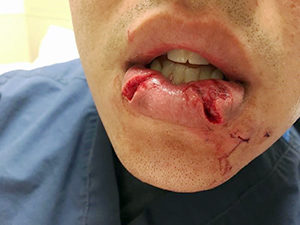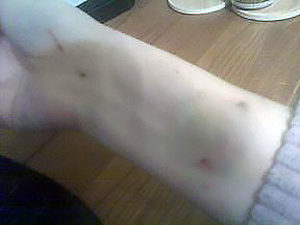At the end of July 2017, I attended the American Veterinary Medical Association Convention in Indianapolis, IN. This was pretty exciting for me as I was selected as a poster presenter for my survey “Once Bitten, Twice Shy – Bite/Near-Bite Job Stress in Veterinary Medicine.” In addition to the poster presentation, I was also selected to lead a round table discussion on the same topic.
Last summer (2016), I proffered a 10-question survey to a number of veterinary groups. This was an effort to gather data on job stress due to bite and near-bite injuries in small animal practices. As a speaker, I was often asked by attendees who had been bitten, how to be less nervous at work. As I was beginning my research, I found few surveys or research that had already been done on this subject, so I ran my own, independent of any sponsors or affiliations. I have since presented the findings at the Midwest Veterinary Conference in Columbus, Ohio (February 2017) and at my Low Stress Handling CE days in Tuscola, Illinois (September 2016).
Creating the poster was a little bit of a challenge since I had never done this before, and the guidelines from the AVMA were very broad. So, I felt a bit lost creating the poster, but Dr. Paul Eubig from the University of Illinois College of Veterinary Medicine was a huge help. Having previously presented a behavior lecture in his pharmacology course, he was happy to respond to my plea for help by sending me a template and giving constructive criticism on my draft. Nancy Oliver, who is in the design group at University of Illinois College of Veterinary Medicine, printed my poster on very short notice and helped tweak the lay out as well. A huge thank you to both Paul and Nancy. I could not have had my poster ready without you.
The round table event was fun. There was food, drinks, and 30 different experts at tables presenting on a topic for 10 minutes, then leading a discussion with their table’s participants. There were 3 rotations of 20 minutes each for the hour and a half of the event. I had a full table at each turn, with different input from each group. I presented a summary of the survey results which are as follows:
- Responders were DVMs, licensed techs, and on-the-job trained staff with over 5 years of clinical experience.
- The scenarios for bite/near-bite injury were
- Greeting the animal (29% of injury risk)
- Blood draw
- Nails
- Feet handling (40.1%)
- Rectal
- Ear
- Oral
- Painful exam (29%)
- Transfer while sedated (14%)
- 75% claimed the bite came without warning, yet 70% indicated that there were signs of anxiety and early aggression before the bite, which was not recognized for the bite risk.
- Methods to reduce job related stress included
- Asking help from a co-worker (55.5%)
- Requiring use of muzzle, sedation or other safety measures (58.2%)
- Avoidance of fractious animals (36.4%)
- 42% reported prolonged stress post bite/near-bite with an additional 33.4% who indicated stress “just for the day.”
- 12% of responders considered leaving the practice they are at due to injury risk, with 1.46% leaving practice (career change) due to job related stress.
From the survey comments, taking courses in Low Stress Handling and behavior, and having the support of the DVM for sedation and pre-exam medications is what reduced job related stress the best.
At the round table discussions, there was a mix of experienced DVM’s, practice managers, technicians, and veterinary students. Much of our discussions centered on how to improve staff awareness of bite risk. As one DVM stated, “It seems they need to get bitten in order to realize there is a bite risk.” Many agreed with this statement. Taking the time to train new staff in handling and recognizing the body language of stress is also a challenge. When a new person has been added to the staff, they are handling animals before they have even received this training. Ideas for training and handling protocols was also discussed.
Other points of discussion were how to approach an animal when it is agitated, reducing travel stress, and reducing the intensity of handling. The seasoned DVMs had the most input about the importance of not pushing through care. Many stated that it seems there is a focus on getting the task done without paying attention to the animal’s response, so fear builds and becomes aggression. The veterinary students brought up how they feel about their lack of preparedness for knowing how to reduce stress in an animal. As one student asked, “So I can tell this animal is a yellow or red for stress, but what do I do now?”
In discussing the technician programs, while some are including behavior and low stress handling in the curriculum, few are addressing handling aggressive animals in a less stressful way. Considering the number of aggressive animals adopted out of no-kill shelters, preparation for the aggressive animal is important.
We all agreed more surveys are needed to dig deeper into this topic. At my poster presentation, people would wince at the bite photos, but acknowledged that these injuries happen and we must have more knowledge and education to reduce this.
Overall, it was a great weekend. I learned a lot and gathered numerous ideas to write about in an effort to create products to help veterinary care be less stressful for patients, owners, and staff. On a personal note, I was also able to meet up for brunch with two of my Purdue suite-mates. We had a great meeting and it was hard to believe it had been 37 years since our “suite life” at Earhart hall.
Further Reading:
- Was It Just a Little Bite or More? Evaluating Bite Levels in Dogs
- Preventing Dog Bites by Learning to Greet Dogs Properly
- Body Language of Fear in Dogs (Poster)
- Help, My Dog Bites! How to Deal with Dogs Who Bite.







